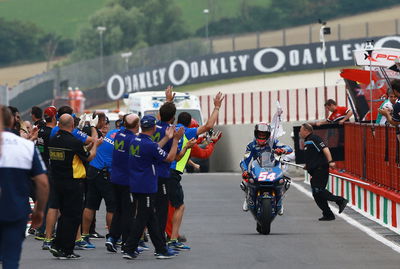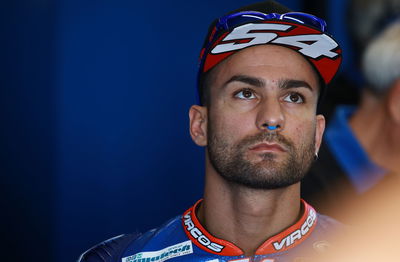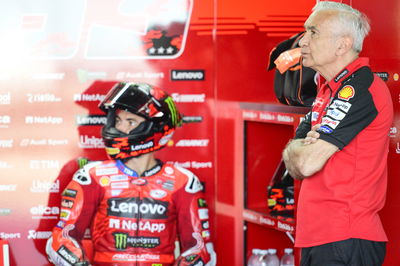‘You ride a bike with your balls, not your arms’
Of the thousands of undulations that zigzag their way across the Tuscan countryside, few can boast of the worldwide fame as one half-mile stretch wherein the Circuit of Mugello resides. The right-left Casanova-Savelli switch, that precedes the run to the uphill Arrabbiata double right, has long been regarded as the finest racing tarmac Italy has to offer. After all, Valentino Rossi holds it in the highest of regards, rating it as his favourite series of bends anywhere on the racing calendar.

Of the thousands of undulations that zigzag their way across the Tuscan countryside, few can boast of the worldwide fame as one half-mile stretch wherein the Circuit of Mugello resides. The right-left Casanova-Savelli switch, that precedes the run to the uphill Arrabbiata double right, has long been regarded as the finest racing tarmac Italy has to offer. After all, Valentino Rossi holds it in the highest of regards, rating it as his favourite series of bends anywhere on the racing calendar.
Fellow Italian Mattia Pasini agrees. “Two historic corners,” he calls them. “The best two corners in the world.” It is little wonder then that 32-year old Pasini chuckles and grins when recalling the last time he took this famous downhill plunge at racing speed. For it was the scene of a dramatic double-overtake on the final lap of a pulsating home grand prix.
Strong on the exit of Casanova all race long, his lunge past Alex Marquez at Savelli to go second came as no surprise. But carrying his speed to line up leader Thomas Luthi at Arrabbiata 1 was something to behold. Third to first in 6.25 seconds, little more than the blinking of an eye. Spanish sports daily AS called the moves “works of art.” Rossi himself took great pleasure in the final lap. “He did the race that every Italian rider dreams about at night,” he later said.
That it crowned a breath-taking win in front of a sell-out crowd was almost secondary. This was Pasini’s first grand prix win in eight years, very much heralding the return of one of grand prix’s forgotten men. “After ten years and after my situation - one year stopped - with one race like this, one last lap like this, passing two riders in two corners – but two historic corners, the best two corners of the world - is, you know, something special,” he warmly recalls. “Winning before, I enjoyed it a lot,” he says. “But not like this. This was very good revenge and I enjoyed every second.”
Interesting that Pasini should use ‘revenge’ when detailing this, his most recent win. For his recent road back to the top has been far from straightforward. Once the poster boy for the future of Italian racing, Pasini’s speed aboard 125cc (eight wins, nine further podiums over four seasons) and 250cc (two wins, seven podiums over two seasons) two-strokes was at odds with what followed in the inaugural seasons of Moto2. As national darling Marco Simoncelli, with whom Pasini often scrapped, captured imaginations in the top class, Mattia was stranded in the new intermediate category, struggling to make any impression aboard the 600cc four-strokes.
A serious motocross accident sustained in 1998 had broken bones in close to every part of the Italian’s body and left lasting nerve damage in his right arm, an injury of which the effects and repercussions are still visible today. To an extent he was written off, his final standings of 28th and 24th in the ’10 and ’11 seasons leading many to conclude he did not possess the physical capabilities to handle the heavier machinery.
Speaking to Pasini now, it’s clear this claim still rankles. “I don’t find from the start of Moto2 the correct way of working with this bike… Sure, the start was difficult. I didn’t adapt to the bike. I didn’t adapt to the new person working with me. I went down one tunnel, where everyone starts to say, ‘This bike is too heavy for you, it’s different, your arms…’ Every time this fucking excuse!” And he is in no doubt as to why this concern is insignificant: “This is not true because you ride the bike with the balls, not the arms!”
As if to prove this wrong, he stepped up to MotoGP in 2012, aboard Speed Master’s underpowered CRT Aprilia. But results didn’t exactly capture the imagination. And after a further two patchy years in Moto2, Pasini was forced to face every racer’s nightmare scenario in 2015, entering the year with no full-time ride. “In that moment nobody believed in me,” he says. But there was little time for excessive self-pity. “I ride many, many, many times with the R6. I make the regional championship of motocross. I make training every day like I’m a [full-time] rider. I never think about stopping doing this. I never gave up.”
Some time away did not just re-focus the mind. Pasini had a chance to develop a reworked front brake system, transferring it from the right to left handlebar of his bike. “I invented this ten years ago with motocross,” he explains. “My problem is the extension of the fingers [in the right hand], to make the movement fast to take out [the fingers] then take in.
“I started to think about how I could find a solution. OK, we try to put a left brake and see how we can do it. The first day it was so hard, because I crashed many, many times. But I felt something good. I said, ‘OK. I need to adapt; to adapt my mind; to adapt my automatisme [automatic reflex]. OK, we’ll keep it.’ And day-by-day, we start to feel comfortable. For the consistency, this was a great move. Like this, I am like a hammer,” he says, banging his fist against the table. “It’s so much more precise for me.
“In 2015 when I was at home with my R6 I think one night, ‘Maybe now is the moment to try the left brake on the street bike.’ Also, what I didn’t think about was, when you don’t have the brake on the right arm, where you have the gas, you can then use the throttle for the downshift. I went to the Valencia circuit and I started with the R6 with a normal right brake in one practice. Then I stopped and put the left brake on. On the first lap I was 0.2s faster than before – the first time I ride like this. And we adapted and adapted many things; the setting; the clutch setting; the engine braking…”
So why hadn’t he tried this before then? The answer is simple: “I don’t find the correct people,” Pasini says. “When you are talking about this to somebody, they see you like, ‘OK, you’re crazy! Are you talking seriously? Are you joking?’”
It was also in 2015 he met with Claudio Bellina, owner, with wife Laura, of the Italtrans team. “We went to dinner and talked, talked just like friends. I explained my thoughts. From that moment, he believed in me and I believed in him. Today is the result.” Until this point in the interview, Pasini has repeatedly mentioned the importance of a supportive team environment, knowing those in the garage fully believe in him. He echoes these thoughts again: “Honestly, if you have the correct person around you, you can be strong. If you have people that don’t believe in you around, they destroy you. Especially, my character, I feel a lot this, the people around me, you know? Maybe this affects other riders, other characters less. But for me, this is so important.”
A deal was struck to return to Moto2 with the Italian team in 2016. Crucially, Pasini would have Giovanni Sandi as crew chief and Mario Martini as his telemetry guy, faces with whom he had worked in his earlier, more illustrious days in GPs. “When you stop into the box, and I speak with my chief mechanic, my mechanics, my guys, [I say] just two words and that’s it,” he explains. “They know me. They know what I need.”
There were signs of the old form returning too, as he became further accustomed to the left-hand front brake, and the demands of a Moto2 machine. Strong results in the rain at the Sachsenring and Brno preceded a front row start at Phillip Island, and a consistent weekend at the season finale outside Valencia. Gradually, all the pieces were coming together as 2017 approached.
And bar the first three races, where Pasini crashed in each outing, the potential has been there. Fourth at Jerez was followed by an all-important test at Misano. “There we improved the bike a lot. From that moment we are on the top all the time, and we are strong, we are fast.” Since, Pasini has regularly been in the podium running. But for those costly early season crashes, and disqualification in Barcelona – due to use of oil ‘outside FIM Moto2 specifications’ - it could be so much better. “Without these races we are second in the championship,” he says.
Not that he is overly downbeat. “We need to think in the present. The past is the past. Now we need to look forward to the end of the season, to next season and that’s it.” If Pasini can carry this form into next year, where he is “99.9 percent” sure he will continue with Italtrans, he will pose Marquez et al. a considerable threat.
And while he began the conversation – held on Friday evening at Austria’s lavish Red Bull Ring, shortly after he topped Moto2 FP2 – by saying, “things are better when you’re fast,” Pasini is adamant he has enjoyed each and every experience racing motorbikes, whether the result was good or bad. “Every day I enjoy racing, from when I started to today. Nothing has ever changed. When you are in difficult moments, sure, you enjoy less. But I love the bike. I love riding the bike. I love riding everything. I love staying on the limit and fighting. This is my life. I still enjoy it like the first day.”
If Pasini maintains this enjoyment, and his current momentum, more days, like those experienced in June at Mugello, won’t be far away.
To read the full Q&A interview with Mattia Pasini click here.











